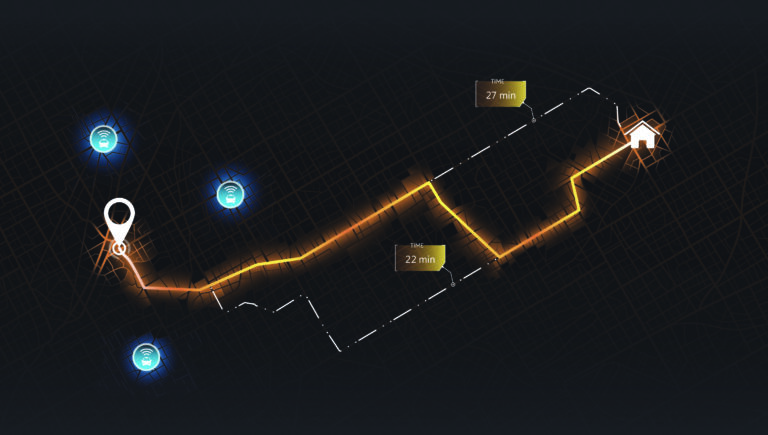Blog
Scenario databases and their impact on the development, implementation and safe use of vehicles equipped with automated driving systems
The implementation of vehicles equipped with automated functions and autonomous vehicles requires research to verify whether new technologies will be safe, both for vehicle users and other road users. However, tests in real traffic conditions are expensive, time-consuming and difficult to implement for various reasons. Therefore, the real traffic testing phase is most often preceded by simulations in laboratory conditions. Data reflecting real conditions (scenarios) are necessary for the correct performance of simulations. The correctness of this data affects the level of safety of automated driving systems (tested using a specific set of scenarios), and thus the safety of using vehicles equipped with them.
Scenario databases take into account many aspects, including diverse environments, weather, road conditions and different behaviors of other road users. Manufacturers of automated driving systems can virtually test their products and initially assess their level of safety by using such scenarios.
One of the world’s largest databases of scenarios dedicated to automated driving systems is the Safety Pool Scenario Database from the UK, which is a collaborative platform for developing and testing automated driving systems worldwide – its goal is to ensure the safety of using automated and autonomous vehicles. The database currently includes over 270 thousand scenarios and connects 200 active users worldwide. The Safety Pool Scenario database collects selected scenarios from many different sources. These are scenarios based on data extracted from recorders during real journeys of vehicles equipped with measuring devices, scenarios generated on the basis of car accident databases, scenarios developed on the basis of the insurance claims register, as well as those based on expert knowledge.
By enabling different entities to submit and share their scenarios with other researchers who can test the systems on test benches or simulation platforms, the Safety Pool Scenario database supports the development, verification and validation of automated systems used in vehicles. Scenarios are prepared based on a specific operational design domain according to the BSI PAS 1883 ODD taxonomy and the emerging ASAM Open ODD (Operational Design Domain) standard. The database allows for the visualization of scenarios (using CARLA software) independently of the platform, i.e. it is possible to execute test cases on different simulation platforms.
Contributions to the database are “rewarded”. Depending on the type of scenario submitted, users can access other scenarios in return. This system encourages users to engage in the development of the database and share their data with other users.
The mission of the Safety Pool is to unite stakeholders from industry, science and decision-makers worldwide in a common ecosystem that aims to ensure the safety of automated driving systems.
In Poland, actions are also being taken to improve road safety. The DARTS project: Database of Autonomous vehicles Road Testing Scenarios, currently implemented by a consortium consisting of the Motor Transport Institute and the Warsaw University of Technology, aims to develop an original database of test scenarios for autonomous vehicles, taking into account road conditions typical of Poland. Entrepreneurs will be able to test automated driving systems using scenarios that take into account data typical for our country.
This database will be the basis for designing, creating, testing and evaluating vehicle perception systems of categories L3-L5 according to the SAE J3016 standard.
The database will contain data provided by various sensors: IMU, GPS, cameras, radars, lidars mounted on a passenger car, specially adapted for the needs of the project. This data, after appropriate processing, will be enriched with annotations of objects of various classes (e.g. vehicles, pedestrians, cyclists). In the process of creating data annotations and testing their quality, artificial intelligence algorithms and advanced methods of digital data processing will be used, including data fusion, automatic detection and tracking of objects, and active learning algorithms.
After the project is completed, the developed database, as a tool necessary for implementing autonomous vehicles, will be made available to interested entities on a non-profit basis, which will certainly contribute to strengthening the potential of the Polish economy and will help shape the country’s development policy in this area.
Source:
www.darts-database.com
drive-safe.ai/news-events/safety-pool
Khastgir S., Safety Pool Scenario Database: Scenario catalogue for Automated Driving System Approval in the UK, UNECE (WP.29/GRVA) Working Party on Automated/Autonomous and Connected Vehicles (18th session) 23 January 2024, Informal document GRVA-18-52 18th GRVA, 22-26 Jan. 2024 Agenda item 4(g)
www.asam.net
***
The DARTS project is financed by the National Centre for Research and Development under grant agreement no.GOSPOSTRATEG- VIII/0001/2022. The entity supervising the implementation of the project is the Ministry of Infrastructure – Department of Transport Strategy.


